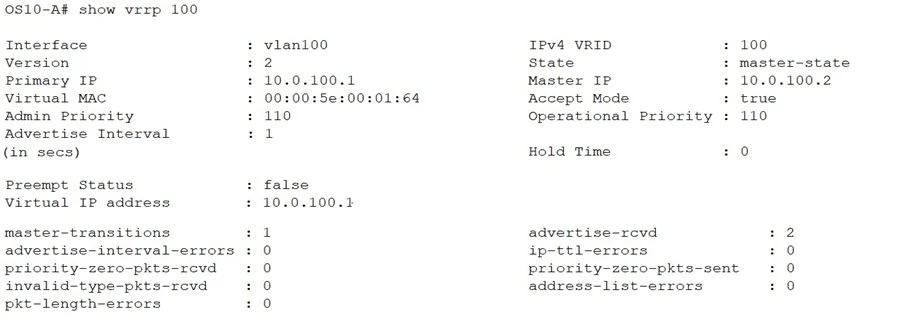The command 'ip vrf' is used to create a non-default VRF (Virtual Routing and Forwarding) instance in the global configuration mode. This command is followed by specifying the name of the new VRF instance.
After receiving a DHCP offer, the DHCP client sends a DHCP request message to the server using a broadcast. This allows all the DHCP servers to see the request and know that the client has selected an IP address offer. Hence, the correct answer is Broadcast.

Refer to the exhibit.
What is the VRRP state of OS10-A after a router with a default VRRP admin priority with VRID100 comes online?
The VRRP state of OS10-A after a router with a default VRRP admin priority with VRID100 comes online would be 'backup-state.' This is because the existing router, OS10-A, has an admin priority of 110. In VRRP, the router with the highest priority becomes the master. The default VRRP priority is typically 100, which is lower than 110. However, the key detail here is that the 'Preempt Status' is set to 'false,' meaning OS10-A will not take over as master if another router is already master, even if the other router has a lower priority. Hence, OS10-A will stay in 'backup-state.'
Dynamic LAGs (Link Aggregation Groups) on Dell EMC Networking OS10 switches comply with the IEEE 802.3ad standard. This standard specifies the procedures for aggregating multiple physical network links into a single logical link to increase bandwidth and provide redundancy. Other standards like 802.3af, 802.3ac, and 802.3ae relate to different aspects of networking technologies, such as Power over Ethernet and Ethernet frame extensions, but not link aggregation.
When configuring a VRF instance for a management interface that has been in use, the first step is to remove all configured settings. This is necessary to clear any existing configurations before applying new VRF settings. It ensures that the interface can be properly assigned to the VRF without any conflicts from previous configurations.